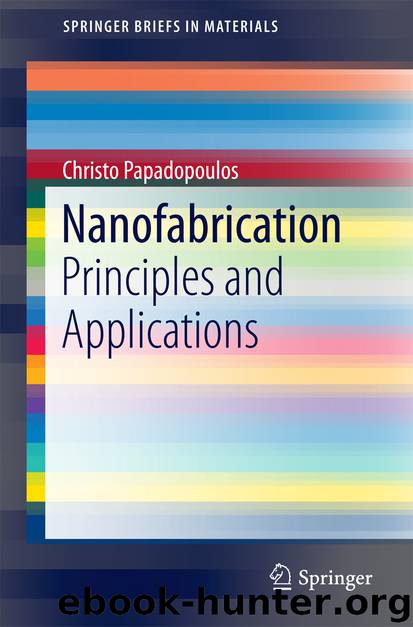Nanofabrication by Christo Papadopoulos

Author:Christo Papadopoulos
Language: eng
Format: epub
Publisher: Springer International Publishing, Cham
7.1 Vapor-Based Growth
We have already seen (e.g., in Chap. 2) several examples of vapor-phase growth techniques, primarily thin film deposition to form nanoscale layers (2D structures) of various materials on a substrate or nanostructure patterns with various types of masks. Growth from the vapor phase can also be used more generally to create 0D and 1D structures directly as discussed below.
7.1.1 Metallic Clusters and Quantum Wells/Dots
Very small clusters of metallic atoms can be formed by the vaporization and condensation of various types of metals. As shown by the example in Fig. 7.1a, by bombarding a metal target and collecting the resulting vapor a beam containing self-assembled metallic clusters is formed. When the distribution of particles in such a beam is examined using mass spectroscopy there are often pronounced peaks at specific cluster sizes (Fig. 7.1b). These peaks can be shown to correspond to the filling of electronic energy levels or shells in a spherical potential well. In other words, the clusters can be viewed as large atoms or “superatoms”. The stability of the closed shell configurations is thus used to explain the higher abundance of certain cluster sizes, which are often referred to as magic numbers. As the clusters get larger however, it is logical to assume that at some stage lattice bonding effects between atoms will start to play a role in the transition from small clusters to bulk crystal structure. This generally occurs when the number of atoms in the cluster, N, becomes greater than ~1000. At this point so-called geometrical magic numbers become dominant, which correspond to the addition of successive layers of atoms (here physical shells of atoms as opposed to electronic shells in the smaller clusters) on top of an underlying crystal structure. For example, icosahedral or twenty-sided shapes (one of the Platonic solids) are quite common for metallic particles in the 5 nm diameter range (see Sect. 7.2) and these types of nanoparticles and others with similar sizes, particularly based on gold, have recently generated intense interest in the field of chemical catalysis.2
Fig. 7.1 a Illustration of small metallic cluster creation via sputtering of a metal target and collection/analysis of resulting vapor [after R.E. Palmer, S. Pratontep, H.-G. Boyen, Nat. Mater. 2, 443 (2003)]. b Observed mass spectroscopy peaks for small Na metal clusters (N = number of atoms in cluster) [after W.A. de Heer, Rev. Mod. Phys. 65, 611 (1993)]
Download
This site does not store any files on its server. We only index and link to content provided by other sites. Please contact the content providers to delete copyright contents if any and email us, we'll remove relevant links or contents immediately.
| Automotive | Engineering |
| Transportation |
Whiskies Galore by Ian Buxton(41720)
Introduction to Aircraft Design (Cambridge Aerospace Series) by John P. Fielding(33017)
Small Unmanned Fixed-wing Aircraft Design by Andrew J. Keane Andras Sobester James P. Scanlan & András Sóbester & James P. Scanlan(32685)
Craft Beer for the Homebrewer by Michael Agnew(18082)
Turbulence by E. J. Noyes(7895)
The Complete Stick Figure Physics Tutorials by Allen Sarah(7267)
Kaplan MCAT General Chemistry Review by Kaplan(6823)
The Thirst by Nesbo Jo(6763)
Bad Blood by John Carreyrou(6477)
Modelling of Convective Heat and Mass Transfer in Rotating Flows by Igor V. Shevchuk(6354)
Learning SQL by Alan Beaulieu(6160)
Weapons of Math Destruction by Cathy O'Neil(6085)
Man-made Catastrophes and Risk Information Concealment by Dmitry Chernov & Didier Sornette(5878)
Digital Minimalism by Cal Newport;(5588)
Life 3.0: Being Human in the Age of Artificial Intelligence by Tegmark Max(5405)
iGen by Jean M. Twenge(5326)
Secrets of Antigravity Propulsion: Tesla, UFOs, and Classified Aerospace Technology by Ph.D. Paul A. Laviolette(5238)
Design of Trajectory Optimization Approach for Space Maneuver Vehicle Skip Entry Problems by Runqi Chai & Al Savvaris & Antonios Tsourdos & Senchun Chai(4957)
Electronic Devices & Circuits by Jacob Millman & Christos C. Halkias(4866)
